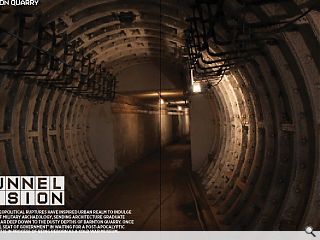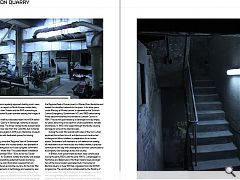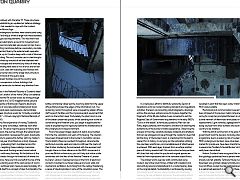Barnton Quarry: Tunnel Vision
10 Jul 2017
Current geopolitical ruptures inspired Urban Realm to indulge in a spot of military archaeology, sending architecture graduate Sean Kinnear deep down to the dusty depths of Barnton Quarry. Once a ‘regional seat of government’ in waiting for a post-apocalyptic Scotland it is in process of being reborn as a Cold War museum.
As diplomatic tensions regularly approach boiling point, news headlines continue to report on North Korean missile tests, an ongoing debate over Trident and the RAF scrambling to intercept the occasional Russian bomber teasing the fringes of UK airspace.All the while, a small but dedicated team work 60ft below ground at Barnton Quarry in Edinburgh, restoring a disused ex-government bunker. The three- storey facility buried below the quarry is a left-over relic from the Cold War, but it intends to open its doors once again in 2019 as an interactive museum and educational hub with dedicated spaces for touring exhibitions.
Barnton Quarry, once the ‘Regional Seat of Government’ for Scotland in the event of a nuclear attack, has operated in a variety of roles dating back to its use by fighter command during the Second World War. The subterranean installation was constructed between 1954 - 56 to act as the ‘Sector Operations Centre’ for Scotland. Initially the facility was tasked with monitoring and plotting potential Russian bombing raids by collating the vast information received from an extensive radar network across the country. As the Cold War era evolved developments in technology and weaponry saw the emergency plans for Scotland in a state of constant flux, subsequently changing the status of the bunker to ‘Air Defence Notification Centre North’ through to 1958. It remained secret until 1963 when a group known as ‘Spies for Peace’ broke into the Regional Seat of Government in Warren Row, Berkshire and leaked the classified network to the press. In its latter years, under Ministry of Works control, it operated as the ‘Scottish Central Emergency Government HQ’ until 1983 before being finally decommissioned and handed to Lothian Council in 1984. The site was purchased by a developer and lay empty for years, becoming a hot spot for urban exploration, vandals and thieves. In 1993 a fire ripped through the facility causing damage to some of the internal areas.
During the Cold War period both sides of the Iron Curtain explored this archaic form of architecture and constructed underground fallout shelters in preparation for a nuclear attack. Switzerland still maintains a civil defence law stating all inhabitants must have access to a fallout shelter; a practice continued to this day with underground bunkers constructed to accompany new buildings across the country.
In Britain, most government bunkers were constructed during the early 1950’s until the early 1990’s. Cultybraggan in Perthshire and Ballymena in Northern Ireland were amongst two of the more modern examples built. The bunker at Barnton Quarry is type ‘R4’ that originates from the ROTOR programme. The construction initiative led by the Ministry of Air appointed Mott Hay & Anderson as the design consultant, the civil engineering firm specialised in tunnel and road solutions within Britain and were involved in the London deep level shelters during the Blitz. The scheme created a network of modular facilities prefixed with the letter ‘R’. These structures were crucial in re-establishing an updated air defence strategy for the nation, one that needed to cope with the modern threats posed in the Atomic Age.
The modular underground bunkers were constructed using the ‘cut and cover’ technique, where a large hole was excavated to suit the facility type size requirements. This was then lined with a course gravel substrate to account for movement and drainage, a reinforced concrete slab was poured on top, then a layer of waterproofing membrane before a secondary concrete slab was laid. At Barnton Quarry the external walls were also reinforced concrete, up to 3 metres deep with a coat of bitumen paint for waterproofing. The roof, concrete cast in steel troughs was capped with a final top mound of soil that blended with the surrounding landscape and removed any trace of what lay beneath. Interior dividing walls were a mix of brick and timber frames, lined with cork, clad with boarding and finished with paint. Access to the tunnel was via the single-story structure used by fighter command at the quarry level.
Other subterranean facilities around the country were accessed through unsuspicious surface buildings that resembled the local vernacular to detract any attention from eyes above.
Declassified files in the National Records of Scotland detail the scientific advisor’s branch of the Home Office civil defence department believed the R4 bunker would be strong enough to survive the scenario of a 3 or 10 megaton bomb, ground or air burst in the centre of Edinburgh. Reports alluding to attenuation factors of concrete walls and blast proof doors designed to withstand peak overpressures, demonstrates that the subterranean structure would be “virtually unscathed from such an attack” – (Crown copyright, National Records of Scotland, HH51/260)
I vividly recall my first experience of visiting ‘Scotland’s Secret Bunker’ in my early schooldays; relatively soon after the Cold War ended. This awe-inspiring piece of history left a permanent impression, the journey through the subterranean spaces inspired a fascination I possessed for years. Eventually I had the opportunity to explore this further with my master’s thesis during my final year of architecture school. However, it wasn’t until after graduating that I stumbled across this restoration project, reigniting these nostalgic memories.
As the visitor descends the long access tunnel natural daylight decreases with every footstep. At the bottom of the slope, a sharp right leads through the threshold of where the blast doors used to be. Here you find yourself at the top of the main stair core; the starting point of the vast warren of rooms and corridors. The rectilinear plan measures approximately 37 x 19 metres and lends itself to a concept of clear functionality; the operations well occupies the heart of the structure stretching the full three underground stories in section. This nerve centre of activity is where the collated information would build the picture of a potential nuclear attack. Senior staff including the battle commander observed the incoming data from the upper offices that enclosed the edges of the information hub. The remaining rooms throughout were occupied by cellular offices, staff support facilities and the impressive plant equipment that exists on the bottom level. Fortunately, the plant room is one of the better-preserved spaces, whilst standing next to the air conditioning and filtration units, you begin to appreciate the scale of engineering and ingenuity behind the maintenance of this underground living environment.
Floors have been largely cleared of debris accumulated from the fire, vandalism and years of fly-tipping. The interiors have been stripped back to the bunker’s monolithic carcass. The brutalist influence is evident throughout, where tactile reinforced concrete walls and columns still bear the marks of their timber shuttering. Accompanied with the exposed roof troughs there is a clear reference to the 1950’s movement in post-war British architecture, you can’t help but notice subtle similarities with the likes of the National Theatre in London by Deny’s Lasdun. Exposed services in the form of electrical conduits mounted to surfaces snake up and over walls and mechanical ventilation ducts hang from the ceiling, threatening a sense of claustrophobia in some of the circulation zones. The intense heat generated from the 1993 blaze has left its mark with small areas of concrete spalling and exposing areas of rebar on the ceiling, allowing a glimpse into the construction makeup.
In a meticulous effort to faithfully restore the Sector of Operations as far as modern building standards and regulations will allow, the team are consulting old photographs, drawings, archive files and eye witness accounts to piece together the fragments of the R4 plan before it was converted to suit the Regional Seat of Government requirements in the early 1960’s. “God is in the details” as famously quoted by Mies van der Rohe, aligns perfectly with the team’s ambitions of retaining the authenticity of the bunker’s holistic appearance. Observing the process of how they carefully stockpile materials and artefacts that can be salvaged and sieve through the rubble for clues that tell the story of the bunker’s past, is a testament to the team’s respect for its history. In carrying out the restoration utilising the volunteer workforce a commendable level of attentiveness is achieved. With each layer stripped from a surface another piece of history reveals itself. Old construction techniques have left clues that help solve the puzzle and original spaces are hinted at from impressions left in the concrete screed floors.
The phased works see new walls constructed using modern day timber stud frames, infilled with insulation and clad with plywood and plasterboard in a contemporary take on the original details. Sustainability is embraced by reusing old strapping and framing where possible and extensively restoring the old ventilation ductwork. The restoration efforts are embodied in the steel roof troughs that are sand blasted clean of the lingering spray concrete finish, before they are recoated in paint that has been colour matched to the original MOD colour palette.
Mechanical and communications equipment that has been stripped of its precious metal components and copper wiring for scrap has prompted the team to utilise a nationwide bunker network of likeminded enthusiasts to procure authentic replacements. Light switches, signage and fittings are slowly being sourced from other bunkers and auctions around the country to be installed.
With the fall of communism in the early 1990’s the government took the decision to slowly phase out the bunker programme due to a reducing risk of nuclear war. Most of the MOD underground bunkers have since been sold on the open market for private use, have been transformed into public museums like ‘Scotland’s Secret Bunker’ at Anstruther or have sadly been demolished.
Historic Scotland have recognised the importance of what this typology symbolises from a period when heightened anxiety was felt globally. Tertowie House nuclear bunker in Aberdeen was granted category B status and Viewmont Council offices nuclear bunker in Stonehaven category C. This is a welcomed approach in preserving these unique artefacts before time takes its toll. With today’s news echoing themes akin to those felt during the Cold War era, history seems to be repeating itself on the political frontline. It is perhaps fitting that these underground structures are being repurposed.
|
|
Read next: Employee Ownership: Owning Up
Read previous: Cosmic Collisions: Star Struck
Back to July 2017
Browse Features Archive
Search
News
For more news from the industry visit our News section.
Features & Reports
For more information from the industry visit our Features & Reports section.





